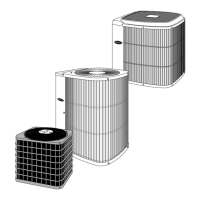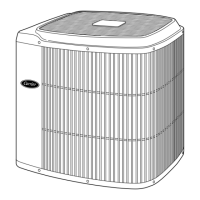
Do you have a question about the Carrier AIR-COOLED CONDENSING UNITS 38EB and is the answer not in the manual?
| Brand | Carrier |
|---|---|
| Model | AIR-COOLED CONDENSING UNITS 38EB |
| Category | Air Conditioner |
| Language | English |
Only trained and qualified service personnel should install or service air conditioning equipment.
Unpack unit, inspect equipment, and complete system requirements before installing.
Connect refrigerant lines to unit service valves using compatible fittings or sweat connections.
Connect wiring according to local and national codes, ensuring proper voltage and connections.
Install branch circuit disconnect per NEC of adequate size to handle unit starting current.
Extend leads from disconnect thru power wiring hole and into unit splice area.
Connect ground lead to ground lug and splice line power leads to unit wiring.
Route 24-v control wires and connect to pigtails supplied with unit.
Check and adjust refrigerant charge for maximum efficiency using specified procedures.
Use recommended methods to check or replace refrigerant charge in the system.
Use Charging Chart Fig. 6 and follow procedures to measure and adjust refrigerant charge.
Use Chargemaster with its associated chart to check and adjust refrigerant charge.
Procedure for removing the compressor from the unit, including refrigerant removal.
Install field-supplied filter drier in system liquid line when refrigerant system is opened.
Procedure to pump down the system for low side repairs without losing refrigerant charge.
Information on high-pressure relief valve, low-pressure switch, overloads, and time guard.
Procedure for repairing mechanical connections on unit service valves.
Adjust fan blade position for proper airflow and operation.
Steps to safely remove the outdoor fan motor for service or replacement.
Guidelines for lubricating compressor and fan motor bearings at specified intervals.
Procedure for cleaning the condenser coil at the beginning of the cooling season.
Troubleshooting causes and remedies when compressor shuts off due to overload or high-pressure switch.
Diagnosing and resolving issues when cooling is insufficient despite compressor running.
Troubleshooting causes and remedies when compressor shuts off due to low-pressure switch cutout.
Diagnosing and resolving issues when the compressor will not restart after shutting off.











